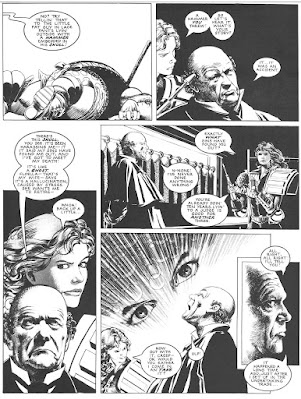Prez
Joe Simon and Jerry Grandenetti
DC Comics, 2016
In late July of 1973, DC Comics released 'Prez', a comic book featuring the nations 'first teen president'. Created by comics veteran Joe Simon, and illustrated by Jerry Grandenetti, the title only lasted four issues before it was cancelled.
This DC Comics graphic novel compiles all four episodes of 'Prez', an unpublished fifth issue, and a grab-bag of other titles (Supergirl, The Sandman, and Vertigo Visions) that featured the character.
(It doesn't compile the super-Woke, super-cutesy 'Prez' series of 2015, which saw the character reinterpreted as a Woman of Color, with tats and a white mohawk hairdo.)
For their comic book excursion, Simon and Grandenetti replaced the Max Frost character with the more wholesome 'Prez' Rickard, native son of the quaint little town of Steadfast, Maine. Aided by Boss Smiley, kingpin of the 'establishment', Prez wins the presidency; however, beneath Prez's seeming naivety is a man with his own mind, and Smiley's hopes to govern the country by proxy are deterred. But there are a host of oldsters who have no intention of letting a teenager rule the country, and no scruples about removing him from office........
At the time 'Prez' first was published, Simon was 59 years old and Grandenetti 47, so they arguably were too distanced from the youth culture (and counterculture) that they sought to portray in their comic.
This lack of familiarity is on display in the four issues of 'Prez', which rather clumsily try to mix the goofy tropes of the 'Archie' comics with efforts to lampoon prominent political movements and personalities.
'Prez' is inevitably dated; for example, I doubt many contemporary readers under the age of 60 would recognize the depiction of star chess player Bobby Fischer as the neurotic 'Chessking':
It's easy to see why 'Prez' failed after four issues. The cartoony artwork and unsophisticated writing were not engaging to the older comic book readership, while at the same time, the book's treatment of the contemporary political landscape could not have been very appealing to the tweener readership of Archie comics.
The 'Prez' stories that appeared in the Vertigo imprint in the mid-90s are more engaging than the original comics, but in my opinion, avoid doing anything truly imaginative or pathbreaking with the concept.
'The Golden Boy' from The Sandman issue 54 (October 1993) does a competent job in terms of recapitulating the Prez myth and its aura of youthful idealism. But the introduction of the 'Sandman' character, and the Goth girl 'Death', in the closing pages undermines the story by imparting a too-trite sensibility......I mean, a Goth Girl with a supersized Ankh amulet hanging around her neck guides Prez to Heaven.........?!
'Prez: Smells Like Teen President', from Vertigo Visions No. 1 (September 1995) is written by Ed Brubaker and illustrated by Eric Shanower, one of the most acclaimed comic book writer / artist teams of the past 30 years. Brubaker gives the Prez mythology a postmodern 90s spin; the protagonist is a disaffected Grunge rock teen named 'P.J.' who may or may not be the illegitimate son of Prez.
P.J. and his buddies set off on a nationwide road trip in the hopes of learning more about Prez and the likelihood that he fathered P.J.
While Brubaker's script is competent, and Shanower's artwork impressive, the story remains predictable, as it simply coats the theme of youthful idealism with a veneer of gritty reality that would be expected of a Grunge-era storyline.
'Smells Like Teen President' is most effective as an example of the progression of comic book mores in the two decades between 1973 and 1995, as its use of profanity and R-rated nudity would have been unthinkable for a mainstream comic in 1973.Summing up, it's hard to conclude that DC's treatments of 'Prez' are very engaging. But to be fair, taking a concept that was most relevant in the tumult of the late 60s, and recasting it either as a 'teen' comic, or a more adult-oriented comic, in any succeeding era is a challenge.
If you are a Baby Boomer, you like the comics of the early 70s, and you can find 'Prez' for under $15, then it may be a worthwhile purchase. But I can't see anyone in any other demographic finding the material to be appealing enough to justify getting it.




















































































